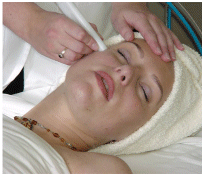|
Below is
a helpful article to better understand Microdermabrasion as done in an
office setting! Microdermabrasion is a general term for the application of tiny rough grains to buff away the surface layer of skin. Many different products and treatments use this method, including medical procedures, salon treatments and creams and scrubs that you apply yourself at home. It's usually done to the face, chest, neck, arms or hands. Before we can understand how microdermabrasion does what it does, it's important to understand how skin works Your skin is made up of two main layers, the epidermis and the dermis. The epidermis is the layer closest to the outside world. It's a set of dead skin cells on top of another layer of cells that are in the process of maturing. The topmost layer is called the stratum corneum. The stratum corneum mostly acts as a barrier between the outside world and the lower skin layers. It keeps all but the smallest molecules from getting through.
When you put lotions or
creams on your skin, some of the moisture passes through the stratum
corneum, but not all of it. This layer is home to many minor skin
imperfections like fine wrinkle lines and blemishes. How it Helps Whether done with a product at home or in a professional setting with a specialized tool, the principal of microdermabrasion is the same. The idea is that if you remove or break up the stratum corneum, the body interprets that as a mild injury and rushes to replace the lost skin cells with new and healthy ones. In the first hour after treatment, this causes mild edema (swelling) and erythema (redness). Depending on the individual, these side effects can last anywhere from an hour to two days.
This process has a few
beneficial effects. With the stratum corneum gone, the skin's surface is
improved. The healing process brings with it newer skin cells that look
and feel smoother. Some of the skin's visible imperfections, like sun
damage, blemishes and fine lines, are removed. Also, without the stratum
corneum acting as a barrier, medicinal creams and lotions are more
effective because more of their active ingredients and moisture can find
their way down to the lower layers of skin. As microdermabrasion
temporarily removes some moisture from the skin, it is always followed by
the application of moisturizing creams.
Professional Treatment
If you went to a clinic
or salon to get microdermabrasion done, the technician or The vacuum action of the machine has four main functions:
Some tools perform all of these functions with one circuit. The suction process in these devices is called Venturi suction. More powerful versions use two circuits, one to shoot the crystals out and another to collect them. There are also newer tools that use a single, diamond-tipped wand on the skin instead of a stream of particles.
< The technician steadily moves the tool over the target area, applying even and steady pressure to remove the stratum corneum without affecting the lower skin layers. A standard session usually consists of one to three passes with the tool. In most cases, the patient is then asked to apply specialized lotions and creams to the affected area between sessions. This rehydrates the area and assists in promoting healthier new skin. These treatments cost around $100 to $200 per session, and several sessions spaced throughout the year are usually recommended for maximum effectiveness. Home Treatment As an alternative to a clinic or salon, there are also microdermabrasion creams and scrubs that you can apply yourself. These contain the same crystals you'd find in professional treatment, but many cut out the use of the specialized tool.You use your hands to rub the products into your face, neck or arms, pushing the crystals against your skin so that they grab and remove the dead cells of the stratum corneum. Some of these creams also contain nutrients and moisturizers -- you remove the dead skin and effectively hydrate the new skin in the same step. Thanks Tammy Johnston for sharing all of this great info on Microdermabrasion! |


